
Published at 6th Sep 2023
Modified at 11th Sep 2023
Starting a British Banknote Collection.
I've always been a collector of "things" and have often tried to work out why this is. After years of internal reflection and deep study I concluded I should give up trying to understand it and get back to collecting.
Most of us have at some stage collected something, or many things. My collecting started with keyrings as a kid and it was simply because "I didn't have one of those". As an adult there are a few things I collect and Banknotes is one area.
The point of this post is to give a little explanation of banknote collecting terms and give a little advice on collecting. My Bank note collection is focussed on British, Bank of England notes, so this is what I'll use for reference, but it translates to many other countries as well.
The subjects I will cover are;
How to start a collection.
How to store and look after a collection.
Grading.
Altered, cleaned and pressed notes.
Terms and expressions such as Replacement, Column Sort, First and Last, Cashier, RADAR, Debden, Reference Numbers and Serials.
Errors and Oddities.
Beyond the face of it.
How to start a collection.
In the simplest terms, buy your first note, you've started. Before you do that, think about what has drawn you to collecting banknotes and where you want your collection to lead. Were you drawn to First issue Britannia 10 shilling notes (10/)? If so start there. If it's more general, start with a plan.
The first step would be to buy a good book, like the selection available on Coins-Auctioned.com. The main books to be recommended are;
English Paper Money : Vincent Duggleby, edited by Pam West. (Incidentally, Pam has a fantastic stock on British Notes).
The Banknote Yearbook: Token Publishing. Token publishing also produce books and magazines on Coins and medals.
English Paper Money (EPM), lists every known variety of English banknote from 1694 onward. It also has a price guide, but please remember it's a guide and notes may cost you more or less. It does not include Scottish or Irish notes.
The Banknote Yearbook (BNY) has a slightly "looser" way of dealing with all of the prefixes and varieties, which I don't like, but it does list notes from Irish and Scottish banks as well as Channel Islands and a section on errors.
I started my collection in a very random way, but you could start in any of the ways below or a combination.
Start with one banknote of each denomination, 10/, £1, £5, £10, £20 and £50. It doesn't matter which issue or Cashier, it just starts you off with something you can fill gaps with. As things progress, you might add in different Cashiers or varieties of note.
Start with one particular denomination and different varieties. You might start with a Series A, Britannia, 10/, add in an Emergency (wartime) issue, then a later Queens Portrait Issue. From there you could add in different cashiers for the same denomination or different serial numbers. Then continue to expand this with all the prefix numbers or start on different denominations.
Attend a fair or browse online and start with the one piece that "speaks" to you.
Or whichever way you feel comfortable.
From there it goes on to completeness, rarities and oddities.
How to store and look after a collection.
As with coin collecting, storing a collection is an area of some debate. Starting with looking after a collection is best.
Handle all banknotes with care. Use fingers not tweezers (in my personal opinion) as fingers are soft and less likely to scratch or mark paper. Before handling any notes, make sure your hands are clean and dry. This is very important as dirt can affect the condition of a note immediately and over time. Wet or damp hands can cause issues with the lacquer on paper and cause ripples. This may not sound like much but this can affect the condition and value of a note dramatically. Take your time and be patient. I have seen far too many notes become damaged by people rushing to put them back in slips or folders. I often keep a microfibre cloth like the one below nearby when I'm handling notes, just to wipe my fingers on to keep them dry and oil free.
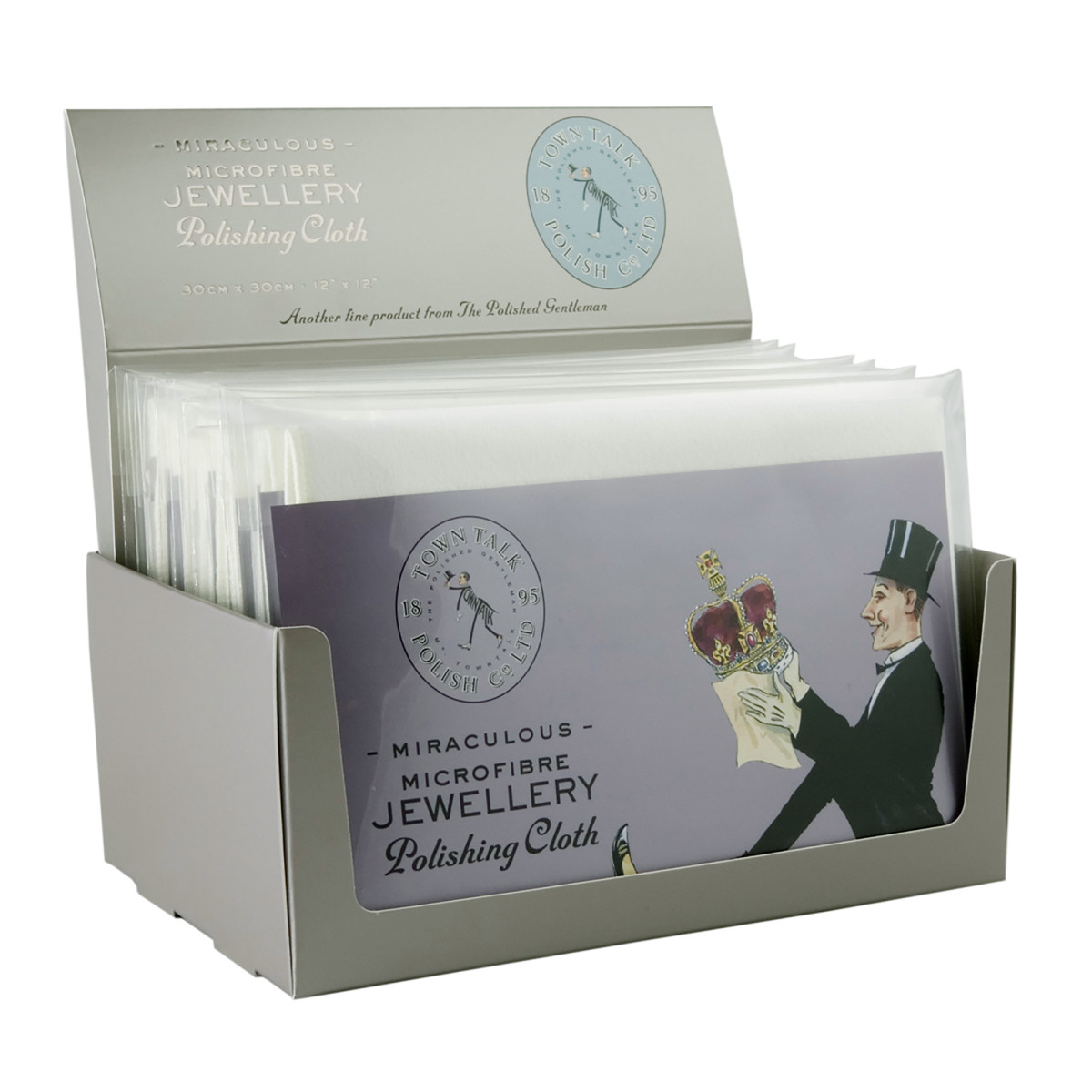 Microfibre cloths are great for quickly wiping over your hands when handling notes and with care can be use to gently remove finger-marks from paper money also.
Microfibre cloths are great for quickly wiping over your hands when handling notes and with care can be use to gently remove finger-marks from paper money also.
Storing a collection can be tricky. There are many Banknote Albums available as are slips/envelopes/pockets/wallets, the name depends on who's selling them. The important thing is to avoid PVC with softeners. This is very specific but there is a reason. Softened PVC releases gases over time which can cause yellowing of banknotes and Verdigris on coins. It can also make notes a little more brittle.
I tend to put all of my collection in plastic wallets and my favourite supplier is SAFE, but of course there are many others. Make sure the sizes you buy comfortably fit your notes as you don't want to be squeezing them in. All of these wallets need to be kept tidy and I use a document safe box as these. These boxes aren't a substitute for a safe or heavy duty security, but they will offer some protection from fire and water, but the aspect I like is they will also exclude a little atmosphere and keep my notes in good condition.
I know many that put notes in wallets and then in albums so they can store more in a smaller space and keep them protected.
You can find accessories for you Paper Money collection on Coins-Auctioned.com here
Grading.
Grading is a difficult thing to get your head around as a beginner. The key is to see plenty of notes and get around to fairs when you can. If there is a local club, go along as there are sure to be people eager to show and tell. Dealers will be all too happy to talk about grading as well. A really good start is to have a look at the International Bank Note Society's grading pages which you can find here. This is a very useful resource with the wording being much more useful than the pictures.
The basic grades are;
Uncirculated (UNC): A pristine unused banknote that has not been in circulation or mishandled. Flat, crisp, square corners, bright colours and with full lustre if applicable.
Almost Uncirculated (AUNC): Pretty much as above but may have a slight fold or counting marks (imagine a clerk licking their finger and counting a stack), but nothing more serious.
Extremely Fine (EF): A good looking note that may have up to 3 light folds or one sharp crease. The paper and ink should be nice and bright with the original sheen or lustre. The corners are permitted to be very slightly rounded.
Very Fine (VF): Generally nice looking and still a little crisp but may have more folds, a bit more rounding of the corners, possibly some dirt and smudging of the ink. Still a very acceptable place to be.
Fine (F): Getting a bit floppy with more folds, dirt and rounding of the corners. There may be some small tears and wear to the edges, but not coming into the main design. The odd pinhole of two is acceptable.
Very Good (VG): Well used, no crispness, rounded and worn edges. Possibly a small hole from hard or repeated folding. The colours won't be as vivid. The note must be complete.
Good (G): Very worn, heavily circulated and limp. Multiple folds, creases, stains, pinholes, dirt, staple holes, holes from folding, small tears. Often written on. No large pieces of the note may be missing.
Fair (F): As above but worse. Pieces may be missing, more writing, dirt etc.
Poor (PR): Yeah, we're now in the area of being good for craft paper and not much else. All of the above but worse. Could be taped together, trimmed down, basically all the bad points. The only reasons to have these in your collection is if they are very rare or you're keeping the place open for a better example.
I will try to put up some pictures of these grades when I can, but I'll probably skip anything below VG as I don't often see them.
What you always have to remember is that grading is a subjective opinion. What I might think is AUNC, someone else might think is UNC and another think EF+. The "+" raises another point to note (excuse the pun). Very often 2 notes will get the same grade, but one will look much better or worse than the other. This is where the "but it's almost an EF, much better than a VF" comes in. It's not uncommon to see EF+, better than EF, but not quite AUNC or AVF meaning it's almost VF.
There is a trend for third party graded notes (and coins) which I generally don't like. Many times pieces are sealed up in wallets or cases which takes away part of the pleasure of collecting notes and that's handling them (very carefully of course). These companies are there to make money and many grade "softly" to ensure more repeat business. This area has a long way to go in my opinion.
Altered, cleaned and pressed notes.
What are these? Let's deal with cleaned and pressed first. Cleaning is washing or wiping over a note with the intention to improve it's appearance. This can make an VF note look like an EF note if a little dirt is removed. What it often does is remove the original lacquer from the note and give it a very matte finish. Pressing is flattening a note either with pressure, such as a pile of books, or with heat and pressure such as an iron. Again, this is used to improve the general appearance of a note.
Whenever a note is cleaned or pressed, it should be disclosed. What looks like one grade could be one or two below and the value would be one or two below as well.
With experience it will be easier to spot if something is wrong with a note. Things to look for are UNC notes with blunted corners, probably cleaned and pressed. A lack of varnish or lacquer on some papers, cleaned and/or hot pressed. What should be raised print (such as Bank of England on many notes) being flat, pressed, either hot or cold. Experience will tell you more.
Altered notes: In the many years I've been collecting I have seen many alterations to make pieces look more valuable. I have seen the results of people hot pressing an extra digit in the serial number to make it a "rare error", inducing or reducing fluorescence of the paper to make "errors" and many other things. There are also many forgeries around, some of which are collectable in their own right. The most worrying development of recent years is the amount of "error" polymer notes. A certain global auction site had listing after listing of rare "error" polymer £5 notes. Missing Elizabeth Towers (what many think of as Big Ben), one eye missing, denomination missing etc. were everywhere. How did the Bank of England mess it up so badly? They didn't. Lots of people were sat at home with cotton buds and acetone (nail varnish remover) scrubbing out portions of the design. My advice on Polymer banknote errors, don't even consider one unless it's something extra rather than missing.
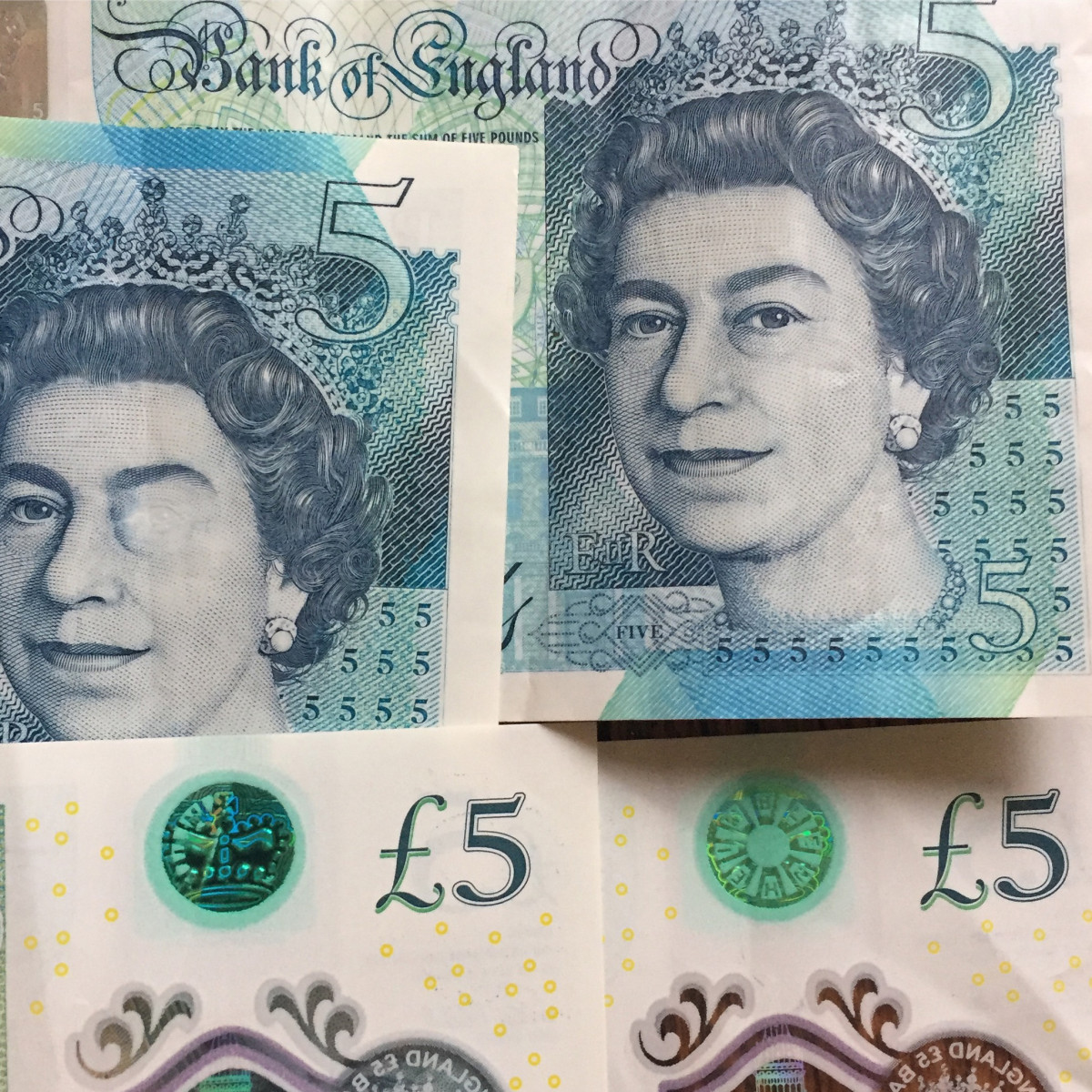 Two fake error Polymer £5 notes. "Misprints" (left) Missing an eye and the device over the holographic crown. Both of these were altered with acetone and not genuine errors.
Two fake error Polymer £5 notes. "Misprints" (left) Missing an eye and the device over the holographic crown. Both of these were altered with acetone and not genuine errors.
Terms and Expressions.
Some of these are straightforward and easy, some are a bit more complicated.
Cashier: The Bank of England appoints a Chief Cashier and their signature is on each banknote issued within their time in office as simple as that. There is one notable exception which was when the signature of David Henry Fitzroy Somerset (D H F Somerset) was omitted from an issue of the £5 note (Duggleby/EPM B343a, BNY BE114).
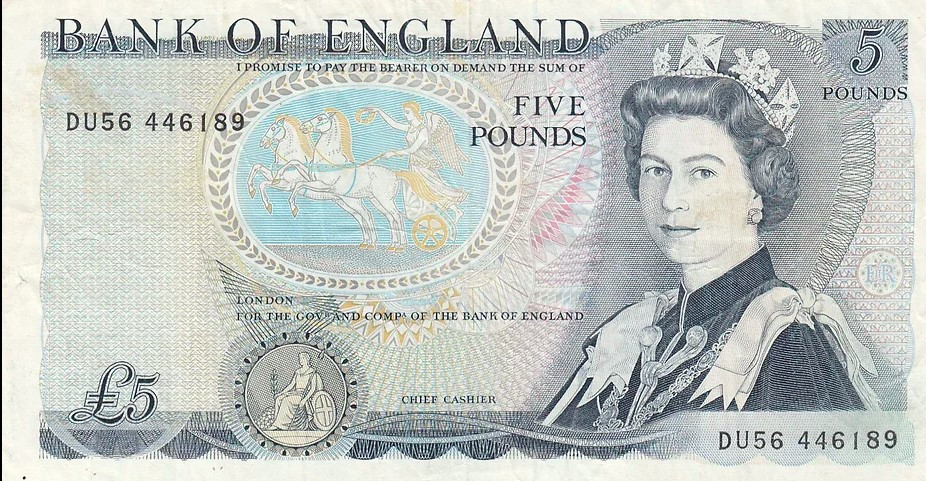
EPM 343a D.H.F. Somerset £5 note with missing signature.
Serial Number: Every (most) Banknotes issued should have their own unique serial number printed on it, much the same as every car has a number plate (or licence plate). This is for identification and record keeping. Paying attention to serial numbers is important as this is where Replacements, Column Sorts, Words, RADAR and series identification comes in. On Bank of England notes, serial prefixes, the first section of the numbers, often follow one of the following formats;
Letter, Number, Number: e.g. X41
Number, Number, Letter: e.g. 41X
Letter, Number, Number, Letter: e.g. C01N (a special one, check out words)
Letter, Letter, Number, Number: e.g. AN01
Treasury Notes had serial numbers with a letter or number above a number or letter. e.g. B over 50 or 99 over B.
First and Last: These are straight forward. When a new note (new cashier or type) is printed, it starts with a particular serial number prefix, for instance a Gill £5 started with RD01 (first run), RD25 would be first series. The last notes printed had the serial prefix of SE90 (last run) and SE25 would be the last series.
Replacement: When banknotes are printed, they are printed in big sheets and cut up afterwards. Each note on a sheet will have a different serial number which helps to keep track of how many and what are being printed. If a sheet gets messed up, badly printed etc. it should come out and be destroyed and a new sheet of replacement notes inserted. The replacements have a different prefix number to help identify them as the records are checked, but the the numbers would be the same as the destroyed sheet. Replacement notes generally command higher prices as there are rarer than the standard issues. Prefixes to easily look out for are "M" and "LL". Notes before 1948 had a more complex format.
Column Sort: When printing was taken over by De La Rue, they sought to cut down on waste from printing errors. Rather than scrap the whole sheet for the sake of a few notes, they guillotined out the notes that were okay and sorted into columns to print with new serials. Column sort numbers tend to look odd as they are outside of the normal number range.
"Special" Serials: Serial Numbers that are more than the sum of their parts;
RADAR: The number version of a palindrome (like radar). e.g. 543212345
Words: It's possible to find words in serials such as the Letter, Number, Number, Letter format that gives C01N, R01L, C01L etc. C01N being a particularly pleasing one for me.
Solid Serials: A repeating single number such as Prefix then 33333333
Million Serials: Prefix then 1000000 or 2000000 etc.
Technically none of these are any rarer than any other. I have a nice B32N 10/ shilling that there is only one of, the same as my slightly worse C01N, but the C01N is more desirable.
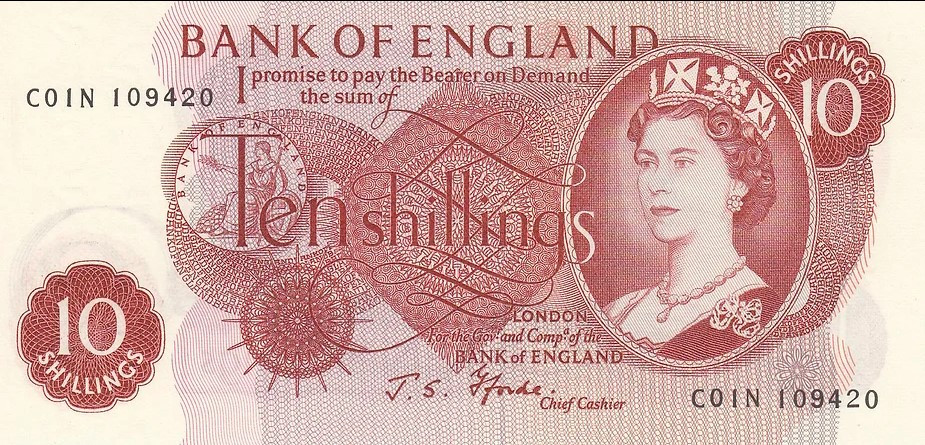
"C01N" Note.
Debden Sets: Debden Security Printing issued a range of banknote sets and I have to admit I'm still a little confused by them. Some were "last serial" sets and then higher last serials were found in circulation. Some were matching serials such as a £5 and £10 with 999500 as the serial etc. which is a bit cool. In short, the sets were issued to get more (quite a lot more) than face value and produce a collectable item. I don't think you can make a collectable, the market decides if it is.
Errors and Oddities:
This is where things get interesting and often very expensive. What is an error? An error is an unintentional defect and usually unique. Now this isn't like coins where many people use the term error when they mean variety. Banknote errors tend to be individual. Errors are not common, reading about Replacements and Column Sorts above should make that obvious.
Under oddities are the amount of experiments and trials. Different printing methods, papers and security features have been tried at certain points, but necessarily adopted as the normal. Look out for different papers "R notes" (with a small R on the back) etc.
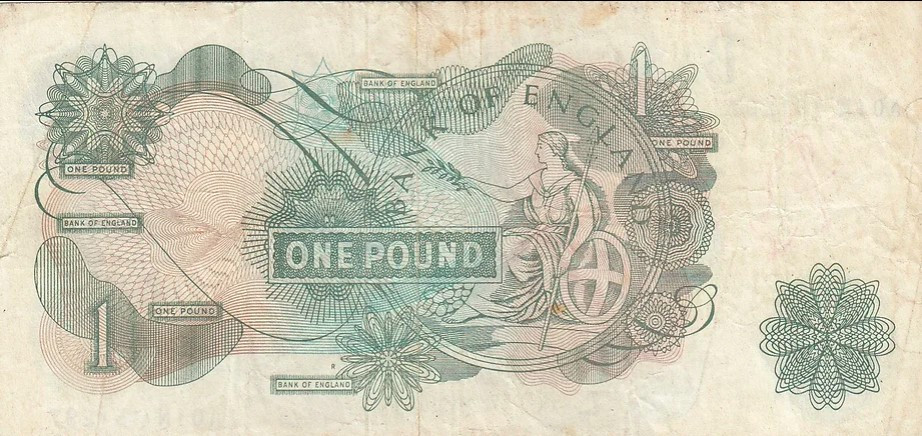 "R" Note. With a small R above BANK OF ENGLAND near the bottom. This indicates a Research note. The type of R can vary and hopefully I'll be able to cover them in a later post.
"R" Note. With a small R above BANK OF ENGLAND near the bottom. This indicates a Research note. The type of R can vary and hopefully I'll be able to cover them in a later post.
What are errors? What are you likely to see?
Printing errors such as areas that are printed too dark, both sides of a note printed on one side, a colour missed, smudging, missed printing, printing on a fold or crease (missed strip of print), foreign objects obscuring the print. As I've mentioned above, beware of modern polymer notes. I don't think I've seen a genuine missing print on one yet.
Serial numbers present problems for printers as well with the same serial on a pair of notes, missing serial numbers, 2 different serial numbers on the same note, missing a digit, improperly printed (e.g. half a 1 above half a 2), the list goes on.
Cutting Errors include extra paper such as when a piece has folded over before guillotining, misalignment with a note being cut too high or too low, total misalignment with half each of 2 notes.
 A "Shark fin" cutting error. The corner of the sheet folded over before cutting leaving this extra piece. This is much less common on more recent notes. A note like this amazes me as I would imagine most would trim it off and use it, especially when you consider what could be bought with 10 shillings at the time. 1 Shilling equalled 12d (12 old pennies), so 10 shillings was 120d (120 old pennies) and in 1948 you could buy 12 pounds (lbs) of cheese for that. In current money 12lbs of cheddar cheese would cost around £45, so you could say it was the equivalent of someone stashing a £50 note.
A "Shark fin" cutting error. The corner of the sheet folded over before cutting leaving this extra piece. This is much less common on more recent notes. A note like this amazes me as I would imagine most would trim it off and use it, especially when you consider what could be bought with 10 shillings at the time. 1 Shilling equalled 12d (12 old pennies), so 10 shillings was 120d (120 old pennies) and in 1948 you could buy 12 pounds (lbs) of cheese for that. In current money 12lbs of cheddar cheese would cost around £45, so you could say it was the equivalent of someone stashing a £50 note.
Miscellaneous Errors crop up as well including no metal threads when there should be, missing or extra watermarks, misaligned metal threads and anything else you can dream up that might have gone wrong.
One very important tip when looking at mis cut (too high or too low) notes is to check the size. I've lost count of the amount of people that have bought an "error" where someone has trimmed the edge.
Oddities include the many specimens, replicas, propaganda notes and forgeries, some of which are very collectable in their own right. It's very interesting to see contemporary forgeries side by side with a genuine note to see what drove the need for innovation in banknote security. Operation Bernhard notes are forgeries, but they are very collectable in their own right, often fetching prices as high as the genuine notes. I don't tend to send people to Wikipedia for information, but the Bernhard write up is pretty much correct.
Beyond the Face of it.
If you start collecting banknotes, you must allow yourself time to look at them, and I mean REALLY look at them. Each banknote is a work of art. Every line on a old note was originally a hand engraved line, take the time to appreciate this. Compare the sheen of notes, the language, subtle changes in colour, use different light sources to appreciate the watermarks and UV markings. If you take the time there is so much more to see.
Article originally written by Damian J Miles and reproduced with permission.
Search the Coin Encyclopedia
Related Auctions
Related Articles
From time to time you will come across an ancient coin with a hole on it. Coins that were holed in ancient times are intriguing. Why was this so?
12th Mar 2018
The first bimetallic coins can be considered some private issues dating from the 4th century AD
11th Apr 2018
Latest Articles
Washington quarters are 25-cent US coins issued since 1932. The original obverse remains, with dozens of varieties and new reverses. Learn the history, types, key dates, and errors on the iconic coin!
4th Nov 2024
Walking liberty half dollars are 50-cent American coins circulated from 1916 to 1947. The iconic design has been featured on the silver eagle bullion since 1986 and remains sought-after by collectors.
7th Oct 2024
Standing liberty quarters were circulated US coins issued from 1916 to 1930 as part of the Renaissance of American Coinage. Learn the values, varieties, and stories of standing liberty quarters!
9th Sep 2024
Article Categories
Collection of articles providing lots of useful information on coins through the ages.
30 Articles




